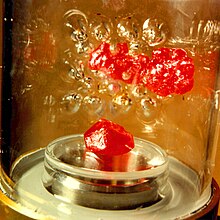Mercury(II) iodide
 Mercury(II) iodide (α form) | |
 Mercury(II) iodide (β form) | |
 β (left) and α (right) forms | |
| Names | |
|---|---|
| IUPAC name Mercury(II) iodide | |
| Other names | |
| Identifiers | |
3D model (JSmol) | |
| ChEBI | |
| ChemSpider | |
| DrugBank | |
| ECHA InfoCard | 100.028.976 |
| EC Number |
|
| 277788 | |
PubChem CID | |
| UNII | |
CompTox Dashboard (EPA) | |
| |
| |
| Properties | |
| HgI2 | |
| Molar mass | 454.40 g/mol |
| Appearance | orange-red powder |
| Odor | odorless |
| Density | 6.36 g/cm3 |
| Melting point | 259 °C (498 °F; 532 K) |
| Boiling point | 350 °C (662 °F; 623 K) |
| 6 mg/100 mL | |
Solubility product (Ksp) | 2.9×10−29[1] |
| Solubility | slightly soluble in alcohol, ether, acetone, chloroform, ethyl acetate, CS2, olive oil, castor oil Soluble in excess KI(Potassium iodide) forming soluble complex K2[HgI4 ](Potassium tetraiodomercurate(II)) also known as Nessler's reagent |
| −128.6·10−6 cm3/mol | |
Refractive index (nD) | 2.455 |
| Structure | |
| Tetrahedral | |
| Pharmacology | |
| D08AK30 (WHO) | |
| Hazards | |
| GHS labelling: | |
   | |
| Danger | |
| H300, H310, H330, H373, H410 | |
| P260, P262, P264, P270, P271, P273, P280, P284, P301+P310, P302+P350, P304+P340, P310, P314, P320, P321, P322, P330, P361, P363, P391, P403+P233, P405, P501 | |
| NFPA 704 (fire diamond) | |
| Flash point | Non-flammable |
| Related compounds | |
Other anions | Mercury(II) fluoride Mercury(II) chloride Mercury(II) bromide |
Other cations | Zinc iodide Cadmium iodide |
Related compounds | Mercury(I) iodide |
Except where otherwise noted, data are given for materials in their standard state (at 25 °C [77 °F], 100 kPa). | |
Mercury(II) iodide is a chemical compound with the molecular formula HgI2. It is typically produced synthetically but can also be found in nature as the extremely rare mineral coccinite. Unlike the related mercury(II) chloride it is hardly soluble in water (<100 ppm).
Production
[edit]Mercury(II) iodide is produced by adding an aqueous solution of potassium iodide to an aqueous solution of mercury(II) chloride with stirring; the precipitate is filtered off, washed and dried at 70 °C.
- HgCl2 + 2 KI → HgI2 + 2 KCl
Properties
[edit]Mercury(II) iodide displays thermochromism; when heated above 126 °C (400 K) it undergoes a phase transition, from the red alpha crystalline form to a pale yellow beta form. As the sample cools, it gradually reacquires its original colour. It has often been used for thermochromism demonstrations.[2] A third form, which is orange, is also known; this can be formed by recrystallisation and is also metastable, eventually converting back to the red alpha form.[3] The various forms can exist in a diverse range of crystal structures and as a result mercury(II) iodide possesses a surprisingly complex phase diagram.[4]
Uses
[edit]
Mercury(II) iodide is used for preparation of Nessler's reagent, used for detection of presence of ammonia.
Mercury(II) iodide is a semiconductor material, used in some x-ray and gamma ray detection and imaging devices operating at room temperatures.[5]
In veterinary medicine, mercury(II) iodide is used in blister ointments in exostoses, bursal enlargement, etc. [citation needed]
It can appear as a precipitate in many reactions.
See also
[edit]- Mercury(I) iodide, Hg2I2
References
[edit]- ^ John Rumble (June 18, 2018). CRC Handbook of Chemistry and Physics (99 ed.). CRC Press. pp. 5–189. ISBN 978-1138561632.
- ^ Thermochromism: Mercury(II) Iodide. Jchemed.chem.wisc.edu. Retrieved on 2011-06-02.
- ^ SCHWARZENBACH, D. (1 January 1969). "The crystal structure and one-dimensional disorder of the orange modification of HgI2". Zeitschrift für Kristallographie - Crystalline Materials. 128 (1–6): 97–114. doi:10.1524/zkri.1969.128.16.97. S2CID 96682743.
- ^ Hostettler, Marc; Schwarzenbach, Dieter (February 2005). "Phase diagrams and structures of HgX2 (X = I, Br, Cl, F)". Comptes Rendus Chimie. 8 (2): 147–156. doi:10.1016/j.crci.2004.06.006.
- ^ Simage, Oy U.S. patent 6,509,203 Semiconductor imaging device and method for producing same, Issue date: Jan 21, 2003


 French
French Deutsch
Deutsch